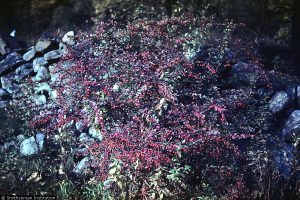Ticks and the Japanese Barberry
Views: 8027

During my many years of designing and maintaining landscapes for people, there are always a couple of the primary considerations (besides being visually appealing) that we looked for when penciling out the plant choices.
These included the hardiness of the plants, as well as deer resistance. I’m sure this is why the Japanese barberry was such a “go-to” cultivar for peoples’ yards and gardens. The green to bronze leaves are pretty, they’re practically impossible to kill, and even the deer pass by them in search of something less thorny. I never liked them because they’re difficult to work around—try weeding around these nasty things—but I know they are very popular.
Downside of the Japanese Barberry
This durable reputation has a surprising cost. A study from the Connecticut Agricultural and Experiment Station links the spread of Japanese barberry (Berberis thunbergii) to the increase in deer tick populations in well over a dozen states.
Many of the good things about the Japanese barberry, as far as landscape design goes, makes it bad as an invasive species. The colorful berries in the fall are a delight to birds, who disperse it in nearby wooded areas. Once there, the Japanese barberry grows vigorously, choking out native vegetation.
There are several problems associated with this prolific growth. In the study they explain the barberry increases the presence of earthworms in the soil, which you would think is a good thing. However, in the forests, leaves and other plant materials need to break down at a certain rate in order to maintain forest health and water quality. When the voracious earthworms finish the job in short order, the process is out of balance. This decreases soil fertility and affects tree and understory growth.
Why Ticks Love Them
The reason ticks benefit from the Japanese barberry is because these thick barberry stands provide an environment with a fairly consistent humidity level of around 80%. It’s tick heaven! It’s also a great place for white-footed mouse populations, which are another Lyme disease vector, so you basically have one big botanical stew pot of a major outbreak. And the numbers show this. In the CAES study, the scientists demonstrated that when you remove the Japanese barberries the number of Lyme disease infected ticks drops from 120 ticks per acre to 12 ticks per acre. That statistic blew me away because now I understand why there is such an issue in some parts of the country.
When I think of ticks, I think of picking them up in the spring while walking through the prairie or visiting the nearby mountain ranges. But when I spoke to a close friend of mine who lives in the Washington D.C. area this summer, I was shocked to hear how many ticks they pick up just on runs or recreating outside. These are urban or suburban areas. Now I understand why. They are living in the middle of a tick nursery.
Destroy Japanese Barberry
The best way to remedy the situation is to never plant Japanese barberries on purpose; tear them out if you have them; eradicate them in wooded areas. But that’s easier said than done. If you cut them down, they will return with a vengeance. A great way to handle them is to cut them and torch them, and possibly torch them a second time later in the year. Here is a fantastic site for the process on barberry control from the CAES: http://www.ctforestry.uconn.edu/documents/CTBarberryHandout2010Jun.pdf
I strongly recommend taking a look at your yard, as well as your surrounding area to see if you have any Japanese barberry growing in your area. And if you find even one plant, show no mercy.
The photo of the barberry is from Richard A. Howard Image Collection, courtesy of the Smithsonian Institute.
Meet Amy Grisak
Amy is a freelance author and photographer in Great Falls, MT who specializes in gardening, foods, and sustainable agriculture. She provides information on every kind…
Amy's Recent Posts

What to do When Pill Bugs Eat Your Plants








